Living with Cats, Rescuing Cats, Fostering Cats and Volunteering—and Pregnant
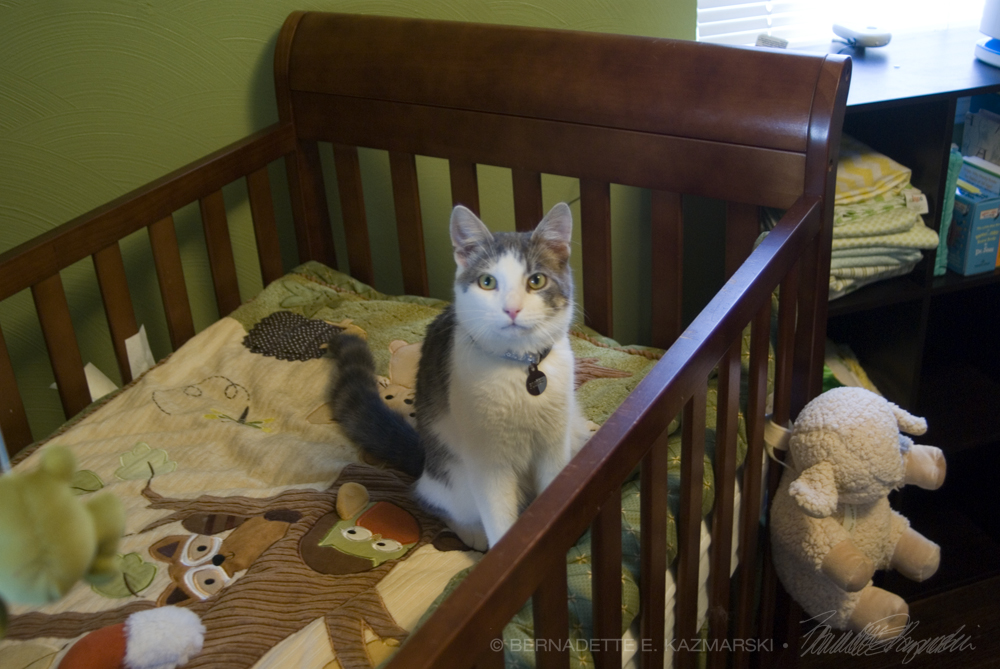
Not only did she not even consider giving up her cats when she found she was pregnant, but Kaytee Bixler continued to take in fosters who needed care and even volunteered at TNR clinics. Foolish? No. Careful is more like it. Kaytee has loved cats all her life and wasn’t about to change her relationship with them when taking simple precautions—things you ought to do anyway—would be enough to prevent her from contracting the illness everyone is concerned about with pregnant women: toxoplasma gondii.
Besides that, some kitties seriously needed her!
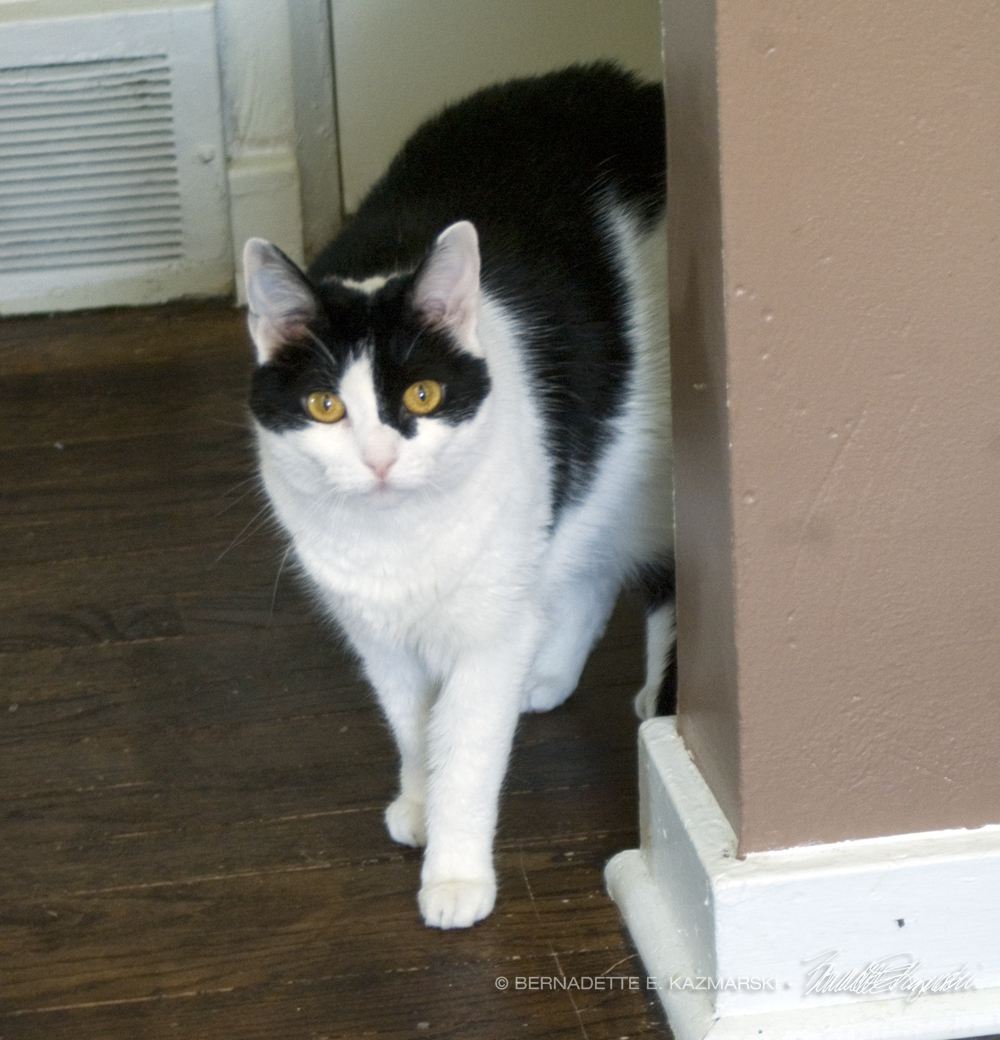
“I’ve had cats all my life, and my mom liked them,” Kaytee said. Those cats were indoor-outdoor and didn’t live too long, but in her mid-twenties she took in a sick kitten born to a friend’s cat, and Olive became her first indoor cat. Olive was still a kitten when she met her future husband Russ and they moved in together, then when they bought their house in 2009 they adopted Fiona and began “cat-sitting” their neighbor’s cat Jack, who was and is indoor-outdoor.
But in the spring of 2013, stray cats “just started showing up in my yard,” and when she researched the internet for ways to help trap and spay/neuter these cats she had a Facebook recommendation for the Pittsburgh Feral Cat Movement (PFCM). “It was such an active place,” Kaytee said. “I thought ‘these are my people!’ “ She used traps borrowed from neighbor Michelle Miller, a member of both PFCM and the Homeless Cat Management Team (HCMT) to take her strays to the clinic.
“Michelle said, ‘You can stay and volunteer if you want,’ which I did, and it really changed my life seeing the cats so vulnerable,” Kaytee remembered.
She found out she was pregnant in August 2013, but she still had a few strays to trap, and continued trapping the cats until October, as long as she could still lift things. “My doctor actually told me to stay away from my cats, keep them out of our beds, off the counters and things, and I thought, ‘Yeah right, like that’s going to happen,’ ” Kaytee laughed. “But my doctor only mentioned toxoplasmosis, didn’t really explain about the disease, so I just knew I shouldn’t clean the litterbox.”
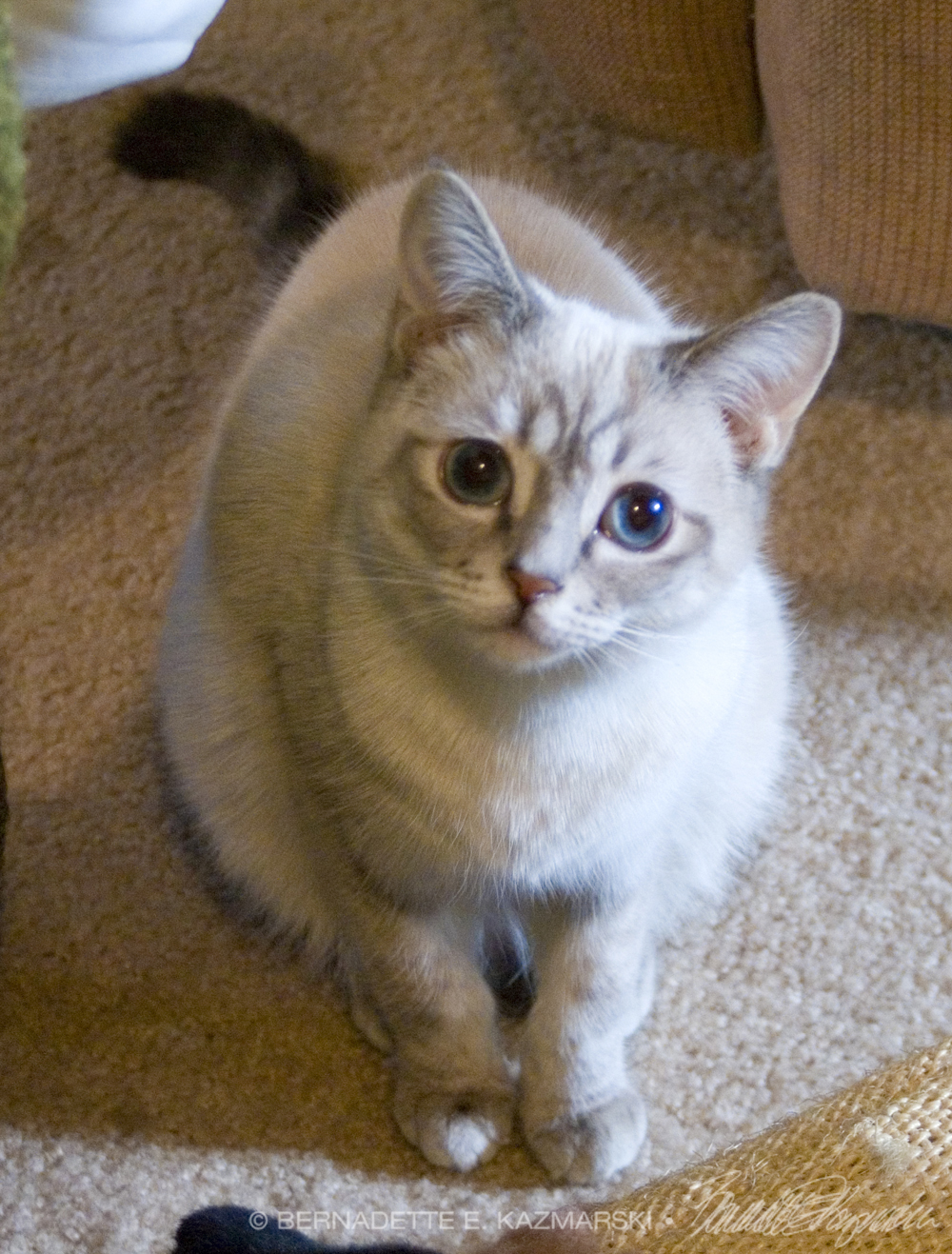
Then in November someone posted in PFCM that a neighbor had apparently wrapped a rubber band around a kitten’s testicles as a DIY neutering. The person who reported got the kitten from the owner and through a series of volunteers in the group the kitten was taken to Kaytee, who had space to foster. That gray and white kitten became a foster failure named Foster, the fourth cat in the house, and the one in the crib at the top of this article. Soon after came Oliver, cat number five. Then two cats who’d been placed as outdoor cats on a farm had to come back in for antibiotics for an upper respiratory infection, and they were friendly anyway, so Simba and Hercules ended up with Kaytee and Russ too. Suddenly seven cats.
“[Since January] I’ve been telling myself to chill with the cat stuff,” she said, “but when an opportunity comes up we’ll take it.”
Another opportunity came along as two cats who needed an emergency home and a spay were mentioned in the group. They were spayed at the HCMT clinic in Tarentum and one was adopted, and the second, Molly, is still in the house.

It’s a good thing Russ is as devoted to the cats as Kaytee is. “I totally turned him,” Kaytee laughs. “Now he’s as bad as me.”
It doesn’t help that Russ works in a home office in the basement, where the cats are quarantined when they first come into the house and if they need to be kept apart from any of the others. They are with him all day long and he gets to know them pretty well. “We start fosters in the basement, and as long as they get along with the other cats they can come upstairs,” Kaytee explained, as the foster cats are introduced slowly and, so far, successfully in their house of eight cats.
And Russ doesn’t mind scooping all those litterboxes and helping manage things so Kaytee can minimize her possible exposure. “I always did the litterboxes, then I got pregnant plus we doubled the number of cats in the house, but he’s okay with that,” Kaytee said. “I’m sure he’ll be glad to give it back!”
So aside from managing the litterboxes, Kaytee was also trapping outdoor cats and volunteering at a TNR clinic where nearly all the cats came directly from the outdoors, plus she took foster cats into her home from the outdoors. How much of a risk did all this contact outdoor cats expose her to?
About Toxoplasmosis and Pregnancy
Toxoplasmosis is an infection caused by a parasite called Toxoplasma gondii. While this parasite is found in many animals and many sites where animals have been, cats are the primary host for this parasite, shedding the infectious stage of the parasite in their feces but for a very limited time after exposure and under very narrow conditions which are easy enough to avoid.
- Cats are exposed to it through eating small rodents and other animals infected with the parasite, so obviously cats who spend part of their time outdoors may have come in contact with the parasite and become infected.
- People are exposed to it by handling cat feces in certain circumstances, but far more often they are exposed to it from handling or eating raw meat, such as a rare steak or sushi with raw meat, handling contaminated garden soil, or even handling or eating raw vegetables that haven’t been washed or not washing their hands afterward.
Cats and people who become infected usually show no symptoms and may feel like they have a touch of the flu. In both cases those with an adequate immune system will just fight it off without any treatment at all like any other mild infection and carry an immunity afterward. People who’ve handled cats for any length of time in their lives may have been exposed to it and carry an immunity and this can be tested.
The problem arises with people with a compromised immune system who can’t fight off the parasite without medical assistance, and pregnant women who may not notice anything themselves but whose fetus may be greatly affected by the parasite with permanent damage to the eyes and central nervous system.
But by using common recommendations for handling the litter box we can all prevent transmission from our cats if they happen to have been infected, including pregnant women.
- Cats shed the oocysts produced by the parasite in their feces for about two weeks after they are infected.
- It takes one to five days after the cat has shed them in their feces for the oocysts themselves to become infective.
Therefore the practices we are all advised with keeping litter boxes clean would prevent transmission of this disease from your cat
- wear gloves when working with the litter box
- scoop every day
- wash your hands with hot soapy water afterward
- wash your tools with hot soapy water afterward
- clean the litter box, litter box area and tools with a bleach-based solution weekly
You can’t breathe in toxoplasmosis nor absorb it through your skin, you have to get the oocysts into your mouth somehow and that’s kind of disgusting considering it’s in cat feces, or into an open wound—and that’s also why it’s more commonly spread from raw meat or uncooked vegetables.
Both cats and people can also get the disease from other sources, and in fact the disease transmission to humans is more frequent from sources other than cat feces:
- eating raw or undercooked meat, especially pork, lamb or venison
- eating unpasteurized dairy products that contain toxoplasma organisms
- eating improperly washed fruits or vegetables
- gardening in contaminated soil
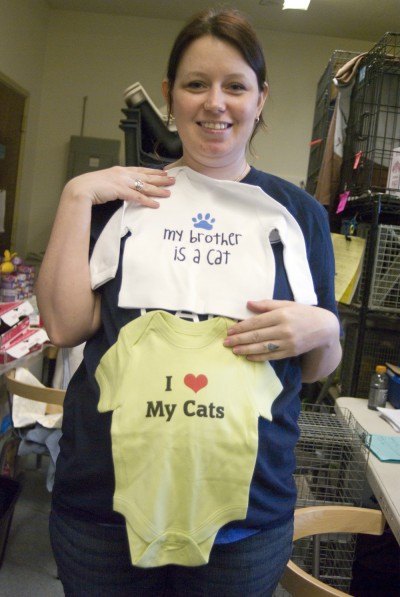
Many doctors advise women to get rid of their cats entirely when they become pregnant, and some women who don’t understand the chances of infection and the simple ways to avoid any chance of it do take their cats to shelters or find other homes for them. In the studies done under the National Council of Pet Population Study and Policy, cats are indeed surrendered to shelters because the owner is pregnant, but what do female veterinarians do when they become pregnant? Quit working? Possibly if they work in a multiple veterinarian practice they can avoid handling cats and doing fecals. But my veterinarian makes house calls and in that way had very little control over the cats she handled day to day but worked all through her pregnancy, and cared for her own household of rescued cats as well, taking the same precautions she gave to any of her clients who were pregnant. Articles and discussions in the veterinary and ob/gyn communities by far advise caution and don’t recommend a woman giving up her cat while pregnant.
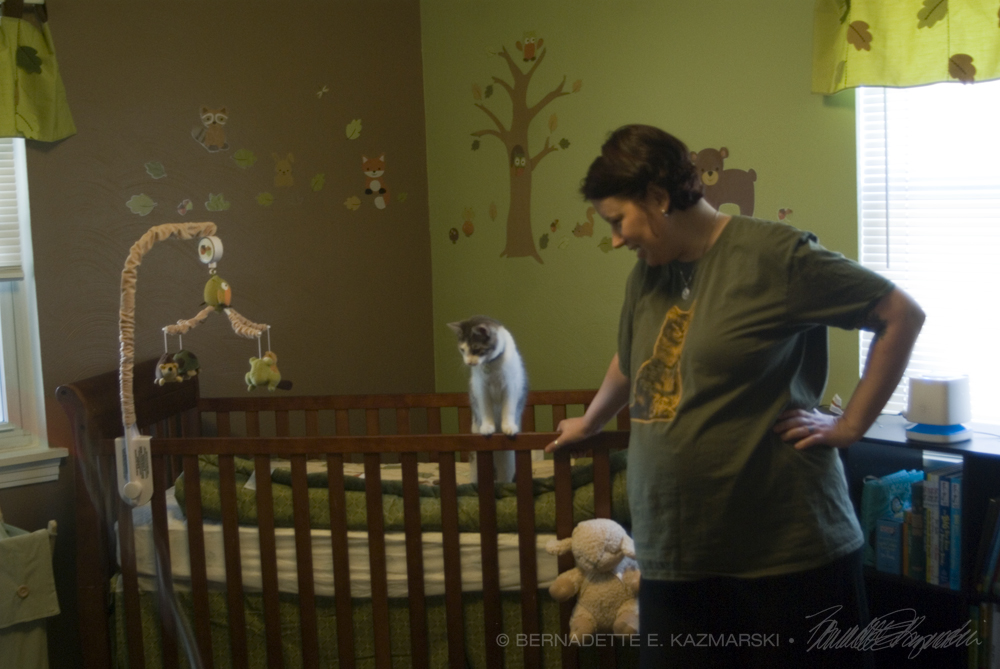
Kaytee is complaining about the lack of sushi in her diet, and she’s also letting her husband take care of the litterboxes as well as frequently cleaning her counters and anywhere else the cats walk, and washing blankets and bedding where they sleep. Her cats eat canned food, no raw diet, and new cats are kept in isolation anyway. When volunteering at the clinic Kaytee is doing paperwork and while she transported the cats she had trapped to the clinic, they were in the trap and handled by others at all other times. Kaytee was aware and doing everything she should do to avoid possible exposure to toxoplasmosis—aside from removing her cats from her life.
But she’s also letting her cats get accustomed to the new baby’s room and things, getting their scent around so the baby is familiar with them, and exposing the baby to them early since studies show this helps to avoid the chances of pet allergies later in life.
Kaytee is due any day now—possibly any moment now—and I hope to do an update on the adjustments in a multi-cat household for the people, the cats and the baby. I’ll bet they’ll teach that baby to wave cat toys in no time! We wish Kaytee an easy delivery and and luck in integrating the new baby with her household.
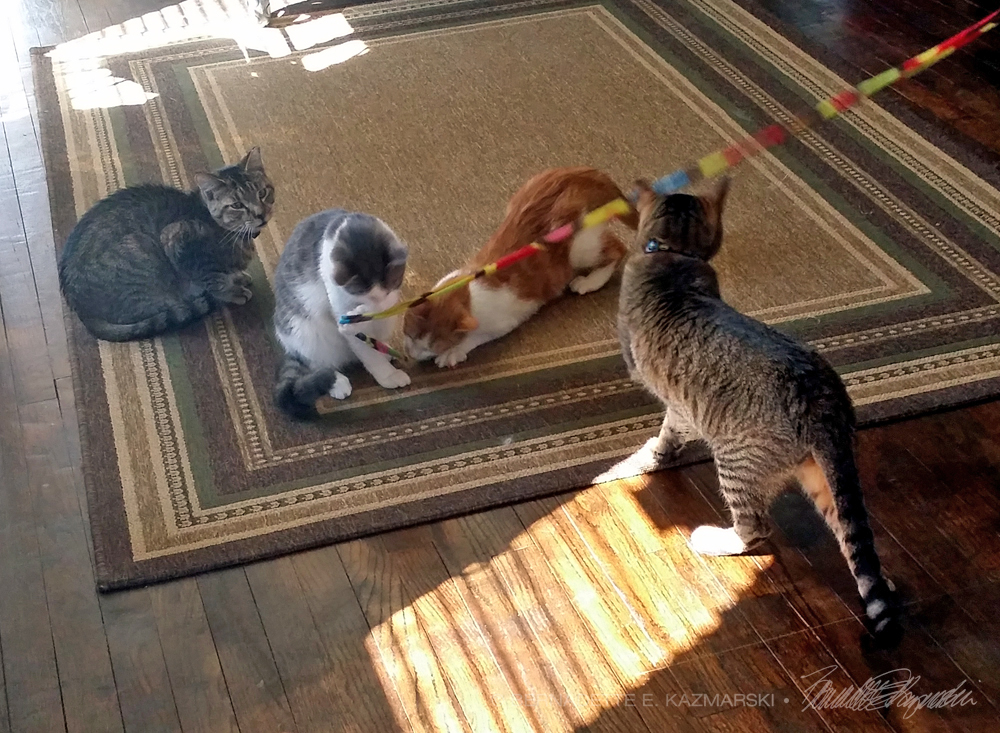
As mentioned, several of Kaytee’s cats are fosters and looking for a forever home. The orange and white boy, Oliver is up for adoption, as is the lovely Molly, who is just now integrating with the rest of Kaytee’s household. In addition, Simba and Hercules are up for adoption and would do best to find a home together—these two tabbies, above, are still less than a year old and already big and muscular, and very energetic, but very people-oriented and playful, especially when they have each other. If you would be interested in adopting any of these four, please contact me and I’ll put you in touch with the organization handling their adoption.
Resources:
Centers for Disease Control: Pregnant Women and Toxoplasmosis
This article has so many links to comprehensive information on the CDC site as well as links to articles and studies elsewhere.
WebMD: Feline Toxoplasmosis
PetMD: Pregnancy and Cat Litter, Feces
HSUS: Pregnancy and Toxoplasmosis, It’s safe to keep your cats
ASPCA: Toxoplasmosis and Cats and Babies
Petfinder: Are Cats Dangerous?
Babycenter: Is it safe to change the cat’s litter box when I’m pregnant?
A friend referred me to this site and others, and I found this discussion between a pediatrician and an obstetrician/gynecologist as well as veterinary technicians and others who work with animals and people very interesting, especially those who were told to give up their cats but would not. Because it’s presumed that all those who handle cats on a regular basis would already have an immunity to toxoplasmosis after repeated exposure, it’s interesting to see the veterinary technician who after years did not have an immunity, and the shelter worker who did not and was unfortunately infected while pregnant. Safety is the key in all these discussions.
National Council of Pet Population Study and Policy: Reasons for Relinquishment of Companion Animals in U.S. Animal Shelters: Selected Health and Personal Issues, Janet M. Scarlett
Read more articles in the category Health and Welfare
Browse some rescued cats and kittens!
All images used on this site are copyrighted to Bernadette E. Kazmarski unless otherwise noted and may not be used without my written permission. Please ask if you are interested in using one in a print or internet publication. If you are interested in purchasing a print of this image or a product including this image, check my Etsy shop or Fine Art America profile to see if I have it available already. If you don’t find it there, visit Ordering Custom Artwork for more information on a custom greeting card, print or other item.
© 2014 | www.TheCreativeCat.net | Published by Bernadette E. Kazmarski
—
Weekly schedule of features:
Sunday: Essays, Pet Loss, Poetry, The Artist’s Life
Monday: Adoptable Cats, TNR & Shelters
Tuesday: Rescue Stories
Wednesday: Commissioned Portrait or Featured Artwork
Thursday: New Merchandise
Friday: Book Review, Health and Welfare, Advocacy
Saturday: Your Backyard Wildlife Habitat, Living Green With Pets, Creating With Cats
And sometimes, I just throw my hands in the air and have fun!
—




Pingback: The Creative Cat - Happy Father’s Day
Pingback: The Creative Cat - ADOPTED! Molly
My very Bes Wishes to You, One and All :))
Thanks for visiting Annie–so far so good!
Pingback: Things Only a Cat Person Would Do | Canidae Blog | Surviving on Terra 3
Pingback: Ayurvedic medicines for your Cat Health | Find Me A Cure